Head MxG 5 Racquet Review
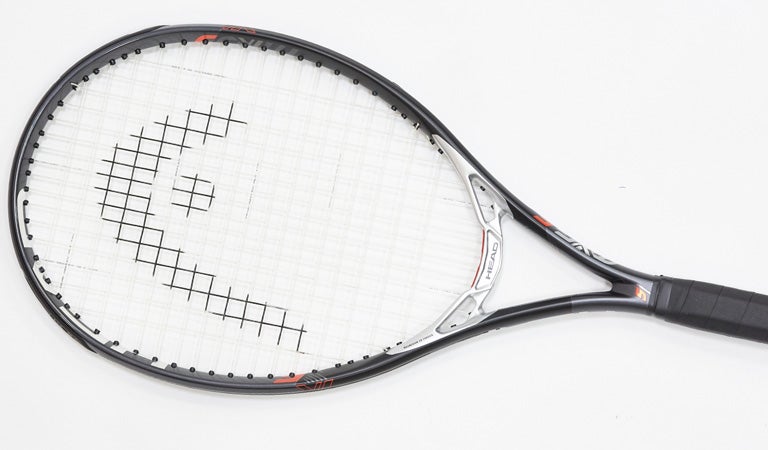
Upsides
- Lots of power
- Generous sweetspot
- Maneuverable
Downsides
- Need to control the power
- Instability against big hitters
Summary
With a tagline of "power under control," Head's new MxG line of racquets has people talking about its unique bridge construction. This throat design allows for more movement of the main strings for greater power and comfort, and the bridge is infused with magnesium (the M in MxG) for stability and control. Graphene Touch material (the G in MxG) is added to the frame for power and dampening. The MxG 5 is an extended length racquet with a forgiving 105 square-inch head and a 16x18 string pattern. The TW playtesters hit the court with this new weapon and found ample power and maneuverability, and a generous sweetspot. From the baseline, the playtesters enjoyed easy depth and plenty of spin. Weighing 10.3 oz strung, the lightweight MxG 5 had some stability issues on volleys and returns of serve, especially when our playtesters were facing hard hitters. Our playtesters also would have liked a little more weight behind their serves. Beginner through intermediate players looking for an easy to use racquet with a generous sweetspot will want to take a closer look at the Head MxG 5.
Head MxG 5 Racquet Scores
| Power | 84 |
| Control | 74 |
| Maneuverability | 85 |
| Stability | 75 |
| Comfort | 79 |
| Touch/Feel | 78 |
| Serves | 76 |
| Groundstrokes | 78 |
| Returns | 76 |
| Slice | 77 |
| Topspin | 82 |
| Volleys | 79 |
| Overall | 77 |
Groundstrokes - Score: 78
The Head MxG 5 offered our playtesters easy pace and depth from the baseline. Mark got things underway in his specific, somewhat ritualistic manner. He explained, "When I playtest a new racquet I avoid looking at its specs, so I have less of a bias as to how the racquet is going to play. After hitting for a while I try to guess what its weight and balance are, and then I measure for the actual specs. I could tell the Head MxG 5 was a pretty light racquet from the baseline, but it was stable enough against the heavier hitters I play with that I incorrectly guessed the MxG 5's weight. To me, it exhibited traits more akin to a high 10 to low 11 oz racquet (not the low 10 oz range). I was able to play both offensively and defensively from the backcourt. Overall, versatility was the storyline for me. Hitting to a smaller target area was easy for me, and the only knock I can give it (from the baseline) is that I had a hard time keeping the ball low over the net, which is probably related to its lighter weight and traditional 16x18 string pattern."
"When I picked this racquet up I knew the specs were a little out of my range," continued Brittany. "However, I have playtested several racquets in this spec range before and have liked a couple (I'm looking at you, Prince EXO3 Silver 115). Right off the bat, I was rewarded with easy power and great maneuverability from the baseline. However, just like with the MxG 3, I didn't have enough control and my groundstrokes were landing about six inches past the baseline on a regular basis. The one thing that surprised me, however, was that the MxG 5 felt more stable than its weight would indicate, and I could redirect hard hit shots with ease. Nonetheless, when I had the chance to end a point by being aggressive I had to hold back, as it was really easy to overhit. I also noticed the ball really sinking into the stringbed and launching off when I changed directions and hit down the line. This caused my groundstroke to drift wider than where I was aiming. One thing to note; I felt the control improved slightly once we strung the racquet with the Head Primal hybrid that was designed for this racquet. Lastly, I was having some small comfort issues in my shoulder when hitting with this racquet."
For Chris, easy power was the name of the game with the MxG 5 from the baseline. He elaborated, "I found I only needed a compact swing to generate depth and pace. In fact, the racquet worked best for me with a compact swing. On longer swings I found it easy to overhit due to the powerful response. I felt the MxG 5 lost comfort on longer swings. If I went for an aggressive topspin shot, which had me hitting higher up in the stringbed, the racquet started to feel brassy. On medium swings it was maneuverable enough for me to swing fast and find plenty of spin. This was a great racquet for slice and dice tennis. I was able to hit some deep slice backhands when stepping in. When I was pushed wide or was off balance my slice lost some of its muster. The MxG 5 simply lacked the mass to help me knife the ball back deep in those situations."
The MxG 5 felt light and was easy to swing for Tiffani. She said, "Even though the MxG 5 is lighter than my own racquet, it wasn't hard to adjust to. I found a rhythm from the baseline quite quickly. I enjoyed rallying with this racquet, and I could hit with depth easily, perhaps a bit too easily. When I or my opponent turned up the speed I ran into some trouble with this racquet. It was harder to control the ball when I was trying to return harder hit shots and when I tried to swing harder. The trajectory of the ball off the stringbed made it harder to predict my depth, which made it difficult for me to develop points. The MxG 5 performed best when I was comfortable and hitting rally balls. The comfort was good for a light racquet, with a bit of a trampoline feel off the stringbed. I liked this racquet both with a full multifilament stringbed and with the Primal hybrid setup. The multifilament offered a softer feel, but the Primal provided extra control."
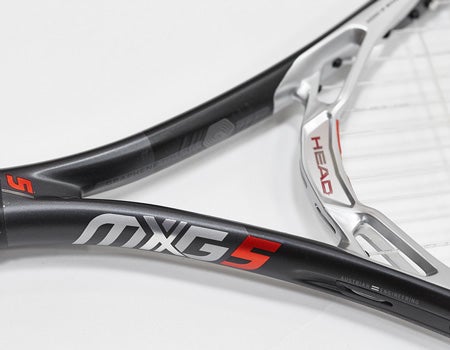
Volleys - Score: 79
With its large sweetspot and excellent maneuverability, the MxG 5 was a hit with the TW playtesters at net. Chris, who really liked this racquet at net, said, "I liked the amount of control I had on my touch volleys, and when I was punching volleys deep the racquet offered easy power. The MxG 5 felt more stable when I was at the net, and I found a better response on defensive volleys than I did on defensive groundstrokes. I also thought the MxG 5 felt more comfortable at the net, and I didn't experience as much of the shock from the upper hoop that I felt from the baseline."
"I enjoyed the generous sweetspot and the quick feel of the MxG 5 at net," added Tiffani. "Transitioning to an overhead from a volley was also seamless. The feel and comfort were surprisingly good for a racquet that's just over 10 oz strung. There are the issues with the stability outside the sweetspot, but that's par for the course with racquets in this weight category."
Brittany had a similar experience while hitting volleys. She said, "The fact that this racquet was so easy to maneuver made it very easy to reflex volley back any ball hit at me. I liked the generous sweetspot and being able to punch the volley back deep. The MxG 5 was lacking a little stability up at net, which wasn't unexpected given how light it is."
Mark agreed with Tiffani and Brittany, saying, "Its maneuverability was the Head MxG 5's strong suit at net, and as long as I nailed the sweetspot the racquet felt quite stable and my volley was effective. That said, once the ball speeds increased it became more crucial that I hit my volley in the center of the stringbed, otherwise the MxG 5 did quiver in my hand a little."
Serves - Score: 76
With the Head MxG 5 being such a lightweight racquet, it came as no surprise that the playtesters were missing a little mass and power behind their serves. Chris served with decent pace and spin with the MxG 5. He explained, "When I got the ball away from the returner my serves were working well. When my serves drifted too close to the returner they seemed to be lacking enough weight of shot to do any damage. I had to be ready for some big returns when I was serving and volleying and didn't get my serves as wide as intended. I continued to enjoy the spin-friendly nature of the MxG 5 on second serves. I was able to keep the pace of my serves up since I found ample spin to get the ball to drop within the lines, but again, anything hit near the returner was attackable."
Mark was left wanting a little more weight. He said, "Although my serve consistency was spot on with the Head MxG 5, this was the one area where I really noticed that it was a light setup. When I'm using heavier racquets it's easier for me to add velocity to my serve without much effort."
"Even though the MxG 5 provided me with a really lively response off the baseline, I was not getting effective power on my serves," noted Tiffani. "Like my groundstrokes, I did initially struggle with the depth control on my serves, and I was hitting them long. I don't usually put a lot of spin on my serves, so I made the extra effort to add spin to bring the ball down inside the court and help keep me from hitting too many sitters to my opponent."
Brittany had some ups and down when it came to serving. She critiqued, "When I was warming up my serve I found it really easy to generate racquet head speed, which translated to easy pace on my first serve. However, since the racquet lacks mass there wasn't a lot of weight behind my serve, and it was sitting up a little too much for my opponent. I started to hit the majority of my first serves with slice, and I found the most consistency and success with this game plan. I had a similar response with my second serve. I could generate spin but my serve wasn't kicking up as high as I would have liked."
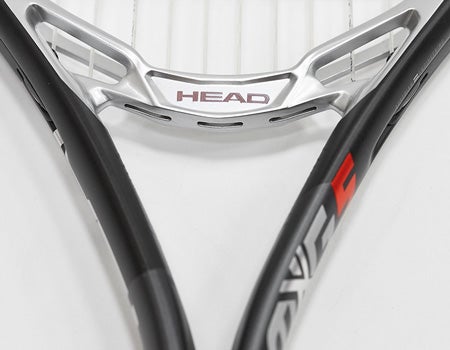
Returns - Score: 76
The quick, fast feel of the MxG 5 allowed the TW playtesters to return with ease. The first thing Brittany noticed when returning serves with this racquet was that her reach felt like it increased an extra six inches. She elaborated, 'I was getting my racquet on some wider serves that I should have had no business making a play on. Even though my return back wasn't the strongest, it was good enough to keep me in the point and give myself a chance to hit another ball. The easy maneuverability allowed me to never be late on a return. However, my one knock would be that I had to be a little more conservative when going after second serves. I had to aim for bigger targets because I felt the directional control was lacking and there was some instances of instability."
Chris found success when returning with the MxG 5. He said, "Another shot which worked well for me with this racquet was the return. When I use a compact stroke I had success redirecting the pace of the incoming ball and sending it back with good spin, depth and power. I was also able to float returns to a deep target to try and neutralize a bigger serve. The serve return was one of my favorite shots with this racquet."
"Like the volley (my return is often like a volley), I could redirect my opponent's pace as long as I made contact with the center of the stringbed, and my return was effective," stated Mark. "When I made contact outside of that area of the stringbed I struggled with the depth and height of my returns."
Tiffani enjoyed the MxG 5's maneuverability when returning serve. She said, "It was easy for me to get the MxG 5 into place, and I returned well enough with it. I didn't feel comfortable with my control so I found myself going back at the server with my returns rather than picking targets closer to the lines. Because it was easy to return with depth, hitting my returns at the server turned out to be pretty effective at times."
Overall - Score: 77
| Technical Specifications | ||
|---|---|---|
| Length | 27.2 in | 69 cm |
| Head Size | 105 sq in | 677 sq cm |
| Weight | 10.3 oz | 292 gm |
| Balance Point | 13.6 in 35 cm | 0pts Even Balance |
| Construction | 24mm / 26mm / 22mm | |
| Composition | Graphite/Graphene Touch | |
| String Pattern | 16 Mains / 18 Crosses | |
| Babolat RDC Ratings | ||
|---|---|---|
| Score | Grade | |
| Flex Rating | 68 | Range: 0-100 |
| Swing Weight | 313 | Range: 200-400 |
| Chris' Scores | |||
|---|---|---|---|
| Power | 8.7 | Serves | 7.6 |
| Control | 7.3 | Groundstrokes | 7.5 |
| Maneuverability | 8.6 | Returns | 8 |
| Stability | 7.4 | Slice | 8.1 |
| Comfort | 7.3 | Topspin | 7.8 |
| Touch/Feel | 7.7 | Volleys | 8 |
| Overall | 7.4 | ||
| Brittany's Scores | |||
|---|---|---|---|
| Power | 9 | Serves | 7.7 |
| Control | 7.3 | Groundstrokes | 7.9 |
| Maneuverability | 8.5 | Returns | 7.6 |
| Stability | 7.5 | Slice | 7.8 |
| Comfort | 7.8 | Topspin | 8 |
| Touch/Feel | 7.8 | Volleys | 7.8 |
| Overall | 7.8 | ||
| Mark's Scores | |||
|---|---|---|---|
| Power | 8 | Serves | 7.5 |
| Control | 7.5 | Groundstrokes | 8 |
| Maneuverability | 8.5 | Returns | 7 |
| Stability | 7.5 | Slice | 7 |
| Comfort | 8.5 | Topspin | 9 |
| Touch/Feel | 8 | Volleys | 8 |
| Overall | 8 | ||
| Tiffani's Scores | |||
|---|---|---|---|
| Power | 7.8 | Serves | 7.6 |
| Control | 7.5 | Groundstrokes | 7.9 |
| Maneuverability | 8.5 | Returns | 7.7 |
| Stability | 7.5 | Slice | 7.8 |
| Comfort | 7.9 | Topspin | 8 |
| Touch/Feel | 7.6 | Volleys | 7.9 |
| Overall | 7.7 | ||
Playtester Profiles
Chris: 4.5 all-court player currently using the Yonex EZONE DR 98+. Chris uses a full-western forehand grip, has a fast swing style and hits a one-handed backhand.
Brittany: Open level player with a semi-western forehand and a two-handed backhand. She currently plays with the Yonex EZONE DR 100.
Mark: 5.0 lefty all-court player with a one-handed backhand. He currently plays with the Babolat Pure Aero Tour.
Tiffani: 4.0 level baseliner with a semi-western grip on the forehand and hits a two-handed backhand. Currently playing with the Prince Textreme Tour 100P.

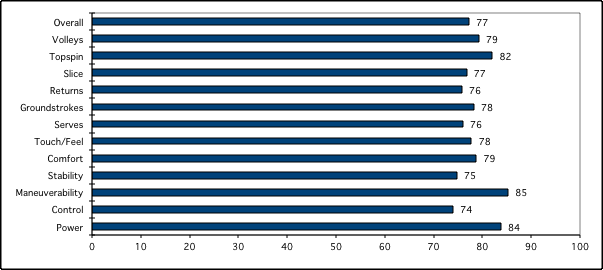






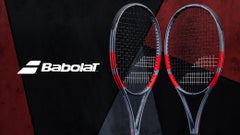








Likes
Brittany- "I liked the easy power and great maneuverability."
Mark- "I like the fact that there is another high quality offering in the 10 oz. range, as I feel it's a valuable range for a lot of players. The MxG 5 is a great racquet for a transitioning junior player. Lastly, for whatever reason, the first thought I had when I saw the new Head MxG series of frames was that the throat insert reminded me of the older Prince Magnesium frames that Pat Cash played with and I loved."
Chris- "Easy depth, pace and spin. The MxG 5 is a great slice and dice racquet, and I had fun attacking the net with it."
Tiffani- "The MxG 5 was easy to swing and has a large sweetspot. Hitting with depth from the baseline was a breeze."
Dislikes
Brittany- "I was missing control and stability."
Mark- "Despite a great frame design, I cannot get around the fact that the Head MxG 5 is just a bit too light for my needs."
Chris- "The MxG 5 lacks some stability for hitting heavy groundstroke, and it felt uncomfortable when my contact drifted higher up in the hoop. All that power made depth control tricky on full swings, although Head's Primal string helped add some control."
Tiffani- "I didn't find enough power on my serves, and I had issues with depth control. The grip got slick quickly, too, but that was easy to fix with an overgrip."
Comparing the racquet to others they've tried, our testers said:
Brittany- "I can't think of a lot of racquets that I have playtested that are super similar to the MxG 5. If I had to pick a some, it would be a blend of the Prince Textreme Warrior 107L, Wilson Blade 104 and Volkl V-Sense 4."
Mark- "Three years ago I couldn't put together a list of more than about four high quality frames in the mid 10 oz weight range. I am happy to say that there are more now, including this new MxG 5 offering from Head. Others that are similar: Babolat Pure Drive Lite, Head XT Graphene Radical S, Babolat Pure Aero Team/ Aero Pro Team, Yonex DR 100 Lite, Yonex SV 100 Lite, Prince Textreme Warrior 100T and Prince Textreme Tour 100L."
Chris- "I would compare the MxG 5 to a Liquidmetal 4 or a Wilson Five. All offer easy pace and depth from a medium length swing and are great options for all court intermediate players. Those who like to play lots of doubles should find plenty of playability to help them move in and attack the ball with any of those offerings. The Pure Drive 107 looks very similar in regards to weight, balance, swingweight and flex, but I've not hit with it recently enough to comment on how the playability compares."
Tiffani- "The feel off the stringbed reminds me of Wilson racquets that have the Power Hole technology. I'm also reminded of Volkl's 4 series racquets."